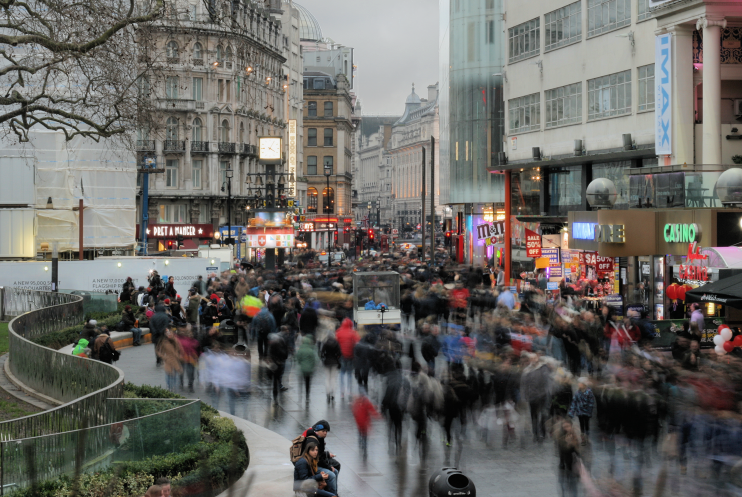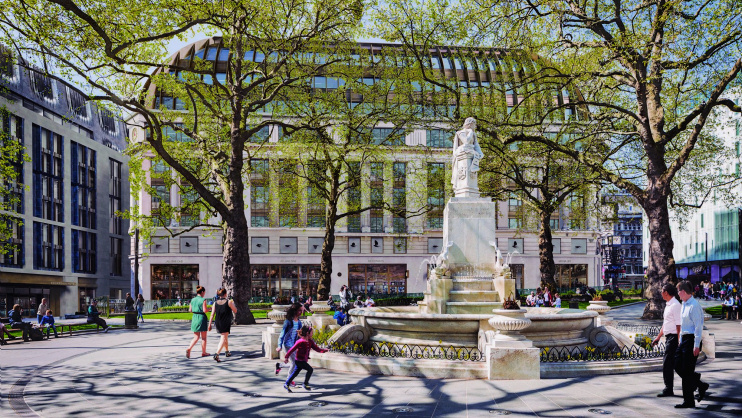Leicester Square
Leicester Square, Westminster
‘The quintessence of the West End’, according to Westminster council, Leicester Square is linked to Piccadilly Circus by Coventry Street

Originally a square plot of Lammas land in the parish of St Martin’s, the area acquired the name Leicester Fields when Robert Sidney, second Earl of Leicester, built a residence here in 1636.
An early version of Leicester Square was laid out in 1665 and houses modelled on those in Pall Mall were built around it. From 1712 to 1760 Leicester House served as a palace for two princes of Wales and the square consequently became a fashionable resort.
In 1771 Sir Ashton Lever converted Leicester House to a ‘museum of curiosities’ called the Holophusicon, which attracted smaller crowds than the street entertainers and gambling dens that were present by this time. Lever also established an archery club that practised in the house’s grounds. He sold the house by lottery and it was demolished a few years later as part of a phase of rebuilding that brought traders and craftsmen to the square in place of private residences and created roughly its present layout.
In 1782 Gedge’s drapers became the first London store to boast a large glass shopfront. A cheap theatre was built on the site of Leicester House, and this was later converted into another drapers shop and then a hotel. Also in the 1780s the pioneering anatomist and surgeon John Hunter assembled a collection of specimens at his large house in Leicester Square, which he arranged into a teaching museum. The house’s contents were purchased by the government in 1799 and now form the nucleus of the collection at the Hunterian Museum.
By the mid-19th century the surrounding locality had acquired a poor reputation, at least among toffee-nosed types. A London guidebook of that period dismissed it as “the very low Leicester-square neighbourhood, chiefly inhabited by foreigners.”
The middle of the square was used for exhibitions (notably in the form of the Great Globe) until gardens were laid out in 1874, with a central fountain and statue of Shakespeare and busts of notable former residents (Newton, Reynolds, Hunter and Hogarth) at each corner.
Theatres, oyster rooms and Turkish baths were by then appearing – and the square’s music halls included the Moorish-styled Alhambra (originally the Royal Panopticon of Science and Art, a well-intentioned failure) and the Empire, which was built in 1884 and rebuilt in 1928 as a cinema, which was acquired by the Cineworld Group in 2016. The Empire’s entrance is visible on the right of the photograph above.
A few Georgian and Victorian buildings survive but most of the square now dates from the 1920s onwards. The Odeon Leicester Square was built in 1937 on the site of the Alhambra and adjoining Turkish baths. The cinema underwent a major refurbishment in 2018. The whole Leicester Square area was pedestrianised in the 1980s.
On the west side of the square a £200m mixed use development transformed Communications House in 2016, whereupon the building was rebranded as LSQ London. It’s shown in the developers’ CGI below, behind what has become known as the ‘Shakespeare fountain’.

On the south side of the gardens, the Society of London Theatre’s reduced price ticket kiosk has become a minor institution. The headquarters of Global Radio and its Capital FM subsidiary are on the east side of the square.
Nightclubs, casinos, bars, restaurants and fast-food joints abound in all directions, and the square’s swirling tide of humanity is a magnet for buskers, flyer distributors and itinerant preachers.
Leicester Square Gardens are given frequent facelifts, including one in 1990 (which followed the construction of a subterranean electricity station that supplies much of the West End’s power), another before the 2012 Olympics and yet another in 2016, when the busts of famous residents were removed because they’d been so badly damaged by the use of corrosive cleaning chemicals during the 1990 facelift. The gardens never look as good as one might hope, but it’s a challenge to beautify a pocket park that has to endure such heavy footfall – as well as regularly being converted into the site of a funfair or other special event.
Betty Miller’s 1934 novel Farewell Leicester Square, which controversially exposed British anti-Semitism, took its title from a line in the song ‘It’s a Long Way to Tipperary’, as did Arthur La Bern’s crime novel Goodbye Piccadilly, Farewell Leicester Square (1966), filmed by Alfred Hitchcock as Frenzy.
Jethro Tull’s ‘medieval rock’ album Stand Up (1969) includes the track ‘Jeffrey Goes To Leicester Square’, in which vocalist Ian Anderson bizarrely mispronounces the word ‘Leicester’.
